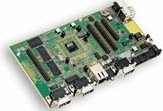ARM9 microcontroller costs $6, runs Linux
Jun 8, 2006 — by LinuxDevices Staff — from the LinuxDevices Archive — 45 viewsAtmel will ship in June the world's first ARM9-based microcontroller (MCU) to support small-footprint RTOSes (real-time OSes), it claims. The AT91SAM9260 is the first of Atmel's SAM9 MCU line, aimed at providing an upgrade path to SAM7 MCU customers in real-time control markets. The SAM9 MCUs support embedded Linux and Windows CE.
SAM9 MCU family
Atmel says its SAM9 line aims to provide an upgrade path to customers outgrowing the 50-60 MIPS (millions-of-instructions per second) limitations of its SAM7-series MCUs, based on ARM7 cores. SAM9 and SAM7 MCUs share “common integration levels, peripheral sets, and programming models,” in order to simplify upward migration, according to Atmel.
In order to support the small-footprint RTOSes typically used in real-time control applications, the SAM9 MCUs integrate an on-chip RC-oscillator; watchdog timer; an 8-level, 32-source priority interrupt controller; DMA; and single-cycle instruction fetch.
SAM9 MCUs also integrate up to 1024KB of Flash memory, because integrated Flash performs better and reduces power consumption, compared to “stacked die” configurations, Atmel notes.
The first SAM9 MCU
The first SAM9 MCU, the AT91SAM9260, is based on an ARM ARM926EJ-S core clocked at 190MHz, with 8KB each of instruction and data cache. Despite being dubbed an MCU, the chip is actually a highly integrated SoC (system-on-chip) — it has 8KB of on-chip SRAM and 32KB of flash, offers an external bus interface with controllers for SDRAM, NAND Flash, and CompactFlash, and integrates a host of on-chip peripheral interfaces.

AT91SAM9260 diagram
(Click to enlarge)
The AT91SAM9260's on-chip peripherals are multiplexed to three 32-bit parallel I/O controllers, in order to reduce pin count. Interfaces include:
- USB Full Speed Host and Device interfaces
- 10/100 Base T Ethernet MAC
- Image Sensor Interface
- Multimedia Card Interface (MCI)
- Synchronous Serial Controllers (SSC)
- USARTs
- Master/Slave Serial Peripheral Interfaces (SPI)
- Three-channel 16-bit Timer Counter (TC)
- Two Wire Interface (TWI)
- Four-channel 10-bit ADC
Additional features include a system controller, reset controller, shutdown controller, clock management, advanced interrupt controller (AIC), debug unit, periodic interval timer, watchdog timer, and real-time timer.
Evaluation board
 The AT91SAM9260 is supported by an AT91SAM9260-EK evaluation board (pictured here) said to have been developed for “highly connected image processing applications, such as point-of-sale terminals, Ethernet-based IP cameras, and bar code readers.” The board supports both Linux and Windows CE, and enjoys extensive support from third-party application development tools, according to Atmel.
The AT91SAM9260 is supported by an AT91SAM9260-EK evaluation board (pictured here) said to have been developed for “highly connected image processing applications, such as point-of-sale terminals, Ethernet-based IP cameras, and bar code readers.” The board supports both Linux and Windows CE, and enjoys extensive support from third-party application development tools, according to Atmel.
Touted board features and peripherals include:
- RoHS-compliant 217-ball LFBGA version of AT91SAM9260 processor
- Atmel serial DataFlash
- Atmel TWI serial EEPROM
- USB device port interface
- Two USB Host port interfaces
- DBGU serial communication port
- complete MODEM serial communication port
- additional serial communication port with RTS/CTS handshake control
- JTAG/ICE debug interface
- PHY Ethernet 100-base TX with three status LEDs
- Atmel AT73C213 Audio DAC
- Power LED and1 x general-purpose LED
- Two user input push buttons
- Wakeup input push button
- reset push button
- DataFlash, SD/MMC card slot
- Four expansion connectors — PIOA, PIOB, PIOC, image sensor
- BGA-like EBI expansion footprint connector
- Lithium coin cell battery retainer for 12 mm cell size
Availability
The AT91SAM9260 is expected to ship this month, priced at $6 in volumes of 100K units. Packaging options include an RoHS-compliant 217-ball LFBGA, or 208-pin Green QFP.
This article was originally published on LinuxDevices.com and has been donated to the open source community by QuinStreet Inc. Please visit LinuxToday.com for up-to-date news and articles about Linux and open source.